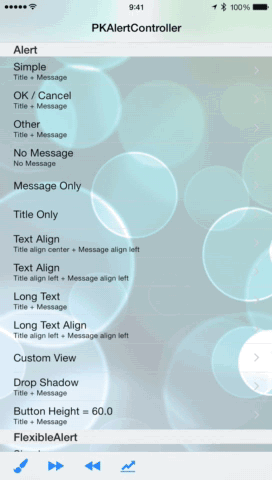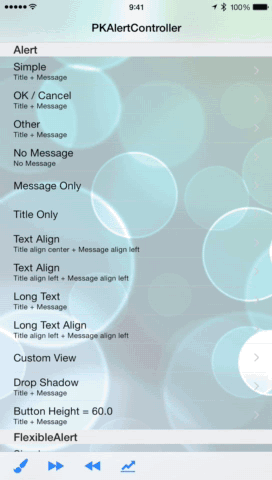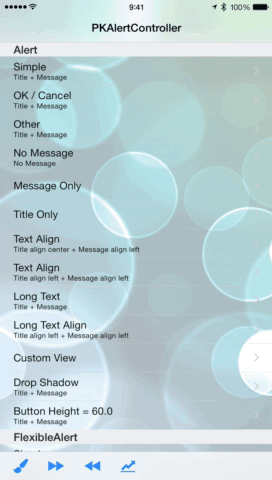PKAlertController 0.6.0
| TestsTested | ✗ |
| LangLanguage | Obj-CObjective C |
| License | MIT |
| ReleasedLast Release | May 2016 |
Maintained by Satoshi Ohki.
PKAlertController 0.6.0
- By
- Satoshi Ohki
PKAlertController is a flexible, highly customizable, many view transitional animation popup view controller.
Screenshots
Features
-
PKAlertControllerhas the title and description label, and you can set a text alignment. - Made with UIViewController-based, so that you can call it as the modal view controller, or add it to some view controller.
- There are many cutom view controller transitions.
- There are some layout styles, and it is the style of the size about the same as a UIAlertview, the flexible size and the fullscreen size.
- To customize UI Color theme, use the class that inherited
PKAlertDefaultTheme. - The view content is customizable to set a custom view same as a titleView of UINavigationItem.
Usage
To run the example project, clone the repo, and run pod install from the Example directory first.
Requirements
- Supported build target - iOS 8.2 (Xcode 6.2, Apple LLVM compiler 6.0)
- supported deployment target - iOS 7.1
Installation
Components
- PKAlertViewController - The root view controller of an alert.
- PKAlertAction - This object represents an action that can be taken when tapping a button in an alert, and like a
UIAlertAction. - PKAlertControllerConfiguration - An object defines the behavior of an alert.
- PKAlertThemeManager - An object that manage the UI Color theme.
Examples
Import
Use by including the following import:
#import <PKAlertController.h>Getting started
// Import this library.
#import <PKAlertController.h>
// Instantiate and configure a simple alert view controller with ok button.
PKAlertViewController *alertViewController = [PKAlertViewController simpleAlertControllerWithConfigurationBlock:^(PKAlertControllerConfiguration *configuration) {
configuration.title = @"Alert title";
configuration.message = @"Alert message";
configuration.preferredStyle = PKAlertControllerStyleAlert;
configuration.tintAdjustmentMode = UIViewTintAdjustmentModeDimmed; // Dimmed view's tint color.
}];
// Call present view controller as modal view controller goes with custom view controller transitional animation.
[self presentViewController:alertViewController animated:YES completion:nil];Text alignment
To set the text alignment of title and message in a alert:
PKAlertViewController *alertViewConroller = [PKAlertViewController simpleAlertControllerWithConfigurationBlock:^(PKAlertControllerConfiguration *configuration) {
configuration.title = @"Alert title";
configuration.message = @"Alert message";
configuration.titleTextAlignment = NSTextAlignmentLeft;
configuration.messageTextAlignment = NSTextAlignmentLeft;
configuration.tintAdjustmentMode = UIViewTintAdjustmentModeDimmed;
}];Action button
// Add common actions.
NSMutableArray *actions = [NSMutableArray array];
[actions addObject:[PKAlertAction cancelAction]];
[actions addObject:[PKAlertAction okActionWithHandler:^(PKAlertAction *action, BOOL closed) {
if (closed) {
NSLog(@"Dismmied the PKAlertViewController!");
} else {
NSLog(@"Tap the ok button!");
}
}]];
// Add a custom action.
[actions addObject:[PKAlertAction actionWithTitle:@"Close" handler:^(PKAlertAction *action, BOOL closed) {
if (closed) {
NSLog(@"Dismmied the PKAlertViewController!");
} else {
NSLog(@"Tap the close button!");
}
}]];
PKAlertViewController *alertViewConroller = [PKAlertViewController simpleAlertControllerWithConfigurationBlock:^(PKAlertControllerConfiguration *configuration) {
configuration.message = @"Alert message";
// Set to the alert configuration.
[configuration addActions:actions];
}];Custom view
// Create a custom view
UINib *nib = [UINib nibWithNibName:NSStringFromClass([PKCustomView class]) bundle:[NSBundle mainBundle]];
PKCustomView *customView = [[nib instantiateWithOwner:nil options:nil] firstObject];
// Set the custom view
PKAlertViewController *alertViewConroller = [PKAlertViewController simpleAlertControllerWithConfigurationBlock:^(PKAlertControllerConfiguration *configuration) {
configuration.customView = customView;
}];And if you implement PKAlertViewLayoutAdapter in the custom view, will get an oppotunity to apply something to PKAlertViewController view components.
#pragma mark - <PKAlertViewLayoutAdapter>
- (void)applyLayoutWithAlertComponentViews:(NSDictionary *)views {
// apply autolayouts to a PKAlertViewController's component.
// contained views in views
// key = `PKAlertRootViewKey`, value = PKAlertViewController's root view.
// key = `PKAlertContentViewKey`, value = PKAlertViewController's content container view.
// key = `PKAlertScrollViewKey`, value = PKAlertViewController's content scroll view.
// key = `PKAlertTopLayoutGuideKey`, value = Top layout guide object.
UIView *contentView = PKAlertGetViewInViews(PKAlertContentViewKey, views);
NSMutableArray *contentConstraints = @[
[NSLayoutConstraint constraintWithItem:self.headerImageView attribute:NSLayoutAttributeTop relatedBy:NSLayoutRelationLessThanOrEqual toItem:
contentView attribute:NSLayoutAttributeTop multiplier:1 constant:0],
].mutableCopy;
NSLayoutConstraint *constraint = [NSLayoutConstraint constraintWithItem:self.headerImageView attribute:NSLayoutAttributeTop relatedBy:NSLayoutRelationEqual toItem:contentView attribute:NSLayoutAttributeTop multiplier:1 constant:0];
constraint.priority = UILayoutPriorityDefaultHigh;
[contentConstraints addObject:constraint];
[contentView addConstraints:contentConstraints];
}
- (void)visibleSizeInAlertView {
// Adjust visible size in alert view.
CGSize size = self.layoutSize;
size.height -= 44;
return size;
}PreferredStyle
The style of PKAlertViewControler. See the example project to use the style.
typedef NS_ENUM (NSInteger, PKAlertControllerStyle) {
PKAlertControllerStyleAlert = 0, // Normal style that the size about same as the size of UIAlertView.
PKAlertControllerStyleFlexibleAlert, // A style of flexible size.
PKAlertControllerStyleFullScreen, // A style of full screen.
};If you use a style of full screen and push it to a navigation controller, Write the following code:
// Create a PKAlertViewController
PKAlertViewController *viewController = [PKAlertViewController instantiateOwnerViewController];
// Create a custom view
UINib *nib = [UINib nibWithNibName:NSStringFromClass([PKCustomView class]) bundle:[NSBundle mainBundle]];
PKCustomView *customView = [[nib instantiateWithOwner:nil options:nil] firstObject];
// Configure behavier
PKAlertControllerConfiguration *configuration = viewController.configuration;
configuration.customView = customView;
configuration.preferredStyle = PKAlertControllerStyleFullScreen; // Set the full screen style.
configuration.statusBarAppearanceUpdate = NO; // Prevent the status bar appearance updating.
viewController.view.frame = CGRectMake(0, 0, CGRectGetWidth(self.view.bounds), CGRectGetHeight(self.view.bounds));
viewController.title = @"Full screen style";
// Push alert to a navigation controller.
[self.navigationController pushViewController:viewController animated:YES];Custom view controller presenting/dismissing transition animation.
To use the animation style, the following code:
// Set the custom view
PKAlertViewController *alertViewConroller = [PKAlertViewController simpleAlertControllerWithConfigurationBlock:^(PKAlertControllerConfiguration *configuration) {
// Set the presenting transition style
configuration.presentationTransitionStyle = PKAlertControllerPresentationTransitionStyleScale;
// Set the dismissing transition style
configuration.dismissTransitionStyle = PKAlertControllerDismissStyleTransitionZoomOut;
}];Change PKAlert view's tintAdjustmentMode
// Set the custom view
PKAlertViewController *alertViewConroller = [PKAlertViewController simpleAlertControllerWithConfigurationBlock:^(PKAlertControllerConfiguration *configuration) {
configuration.tintAdjustmentMode = UIViewTintAdjustmentModeAutomatic; // Default: UIViewTintAdjustmentModeDimmed;
}];PKAlertAction
The action button convenience constructor, one of the following:
+ (instancetype)actionWithTitle:(NSString *)title handler:(PKActionHandler)handler;
+ (instancetype)cancelAction;
+ (instancetype)cancelActionWithHandler:(void(^)(PKAlertAction *action, BOOL closed))handler;
+ (instancetype)okAction;
+ (instancetype)okActionWithHandler:(void(^)(PKAlertAction *action, BOOL closed))handler;
+ (instancetype)doneAction;
+ (instancetype)doneActionWithHandler:(void(^)(PKAlertAction *action, BOOL closed))handler;PKAlertViewController
The alert view controller convenience constructor, one of the following:
+ (instancetype)instantiateOwnerViewController;
+ (instancetype)alertControllerWithConfigurationBlock:(PKAlertControllerConfigurationBlock)configurationBlock;
+ (instancetype)simpleAlertControllerWithConfigurationBlock:(PKAlertControllerConfigurationBlock)configurationBlock;
+ (instancetype)alertControllerWithConfiguration:(PKAlertControllerConfiguration *)configuration;If you like procedural wrinting:
PKAlertControllerConfiguration *configuration = [[PKAlertControllerConfiguration alloc] init];
configuration.message = @"Alert message";
configuration.actionControlHeight = 60;
[configuration addAction:[PKAlertAction cancelAction]];
PKAlertViewController *viewController = [PKAlertViewController alertControllerWithConfiguration:configuration];Or the builder design pattern:
PKAlertViewController *viewController = [PKAlertViewController alertControllerWithConfigurationBlock:^(PKAlertControllerConfiguration *configuration) {
configuration.message = @"Alert message";
configuration.actionControlHeight = 60;
[configuration addAction:[PKAlertAction cancelAction]];
}];Author
Satoshi Ohki, [email protected]
License
PKAlertController is available under the MIT license. See the LICENSE file for more info.





